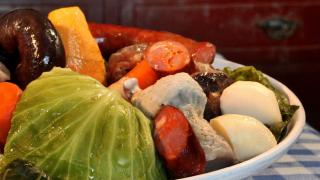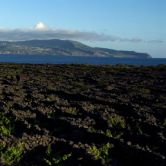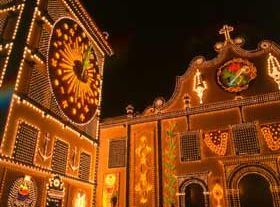Gourmets delight in the many traditional recipes of Azorean cuisine. Here, fish and seafood abound, so those who appreciate a delicious fish straight from the sea will find a paradise in the Azores.
Grilled, in bouillabaisses or soups, fish is cooked in a variety of ways. But make sure you taste tuna which, in these waters, has a pink hue and a soft flavour and texture, is slightly salty and is still caught by hook and line. Or octopus which is mostly appreciated stewed in aromatic wine. The Azores have seafood that is not found anywhere else, such as limpets, barnacles and locust lobsters, a kind of tender and tasty lobster which is almost a sin not to try.
As for meat, there are some typical Azorean dishes, such as cozido das Furnas, unique for being cooked under the ground, harnessing the heat that the earth retains in that part of the Island of S. Miguel. At the right time, you can watch the preparation of the meal by the lagoon. On the Island of Terceira, the focus is on alcatra (fish or beef casserole), well-seasoned as tradition demands, and on the other islands there are several variations on the recipe for yam with sausage.
The bolo lêvedo (leavened cake) from Furnas is also very popular, and goes well with any meal, by itself or with butter or jam. Or with Azores honey, a Protected Designation of Origin product, owing its high quality to the diversity and richness of the flora.
Gourmets delight in the many traditional recipes of Azorean cuisine. Here, fish and seafood abound, so those who appreciate a delicious fish straight from the sea will find a paradise in the Azores.
Grilled, in bouillabaisses or soups, fish is cooked in a variety of ways. But make sure you taste tuna which, in these waters, has a pink hue and a soft flavour and texture, is slightly salty and is still caught by hook and line. Or octopus which is mostly appreciated stewed in aromatic wine. The Azores have seafood that is not found anywhere else, such as limpets, barnacles and locust lobsters, a kind of tender and tasty lobster which is almost a sin not to try.
As for meat, there are some typical Azorean dishes, such as cozido das Furnas, unique for being cooked under the ground, harnessing the heat that the earth retains in that part of the Island of S. Miguel. At the right time, you can watch the preparation of the meal by the lagoon. On the Island of Terceira, the focus is on alcatra (fish or beef casserole), well-seasoned as tradition demands, and on the other islands there are several variations on the recipe for yam with sausage.
The bolo lêvedo (leavened cake) from Furnas is also very popular, and goes well with any meal, by itself or with butter or jam. Or with Azores honey, a Protected Designation of Origin product, owing its high quality to the diversity and richness of the flora.
Amongst desserts, the pineapple has pride of place with its bittersweet taste and very pleasant aroma, and the sweets, of course. Sweet bread, Santa Maria cavacas (sugar-coated biscuits), Vila Franca do Campo queijadas (cheese cakes), donas-amélias (honey cupcakes) and sugar-paste cakes from Terceira, Faial Fofas (fennel-based pastries stuffed with cream), Graciosa queijadas, covilhetes de leite (custard tarts)… it’s almost impossible to list them all. What they share is quality and the affection devoted to their making.
Naturally, given the wide range and tradition of dairy production in the Azores, the islands manufacture various milk products, with a special focus on cheese. The most famous is São Jorge. A whole cheese weighs 8 to 12 kilos, and has a strong character, helped by its spicy flavor. It is made from raw cow’s milk and salt, is yellowish in colour and has a hard or semi-hard consistency, according to how many months it has matured. São Miguel boasts a variety of cheeses, all of different textures and flavours. Graciosa cheese is spicy, with a yellowish colour and a brittle texture. Pico produces a creamy, soft cheese, dense in texture. From Corvo, you get a cheese with a very active flavour, and a semi-fatty, semi-hard consistency. Terceira cheeses are buttery, fresh and mature. And the popular Flamengo comes from Faial.
However, you cannot taste these specialties without the regional wines. Although the verdelho wine is the most well-known, there are others, like the reds and whites from Pico, Santa Maria and Terceira, to accompany your meal. On the latter island, vineyards are predominant at Biscoitos, where you can visit the local museum. There are also passion fruit and pineapple liqueurs to finish off your meal.
Being a land of great religious traditions, the Azores offer a special bill of fare associated with the Holy Spirit festivities. This includes Holy Spirit soup, cozido, alcatra, table bread, unkneaded bread, and sweet bread accompanied by aromatic wine.
The Island of São Miguel is the only tea-producing place in Europe. Plantations have existed on the island since the 19th century, and tea processing has remained unchanged for over two centuries, making it an ecological product, free of pesticides, herbicides and fungicides. Green tea from the Azores is the most popular, although black tea is also produced in different varieties. A good suggestion to end you meal or start your day.












 Explore
Explore 
 Remember and Share
Remember and Share 


